How to Make Goat Milk Soap at Home Without Lye

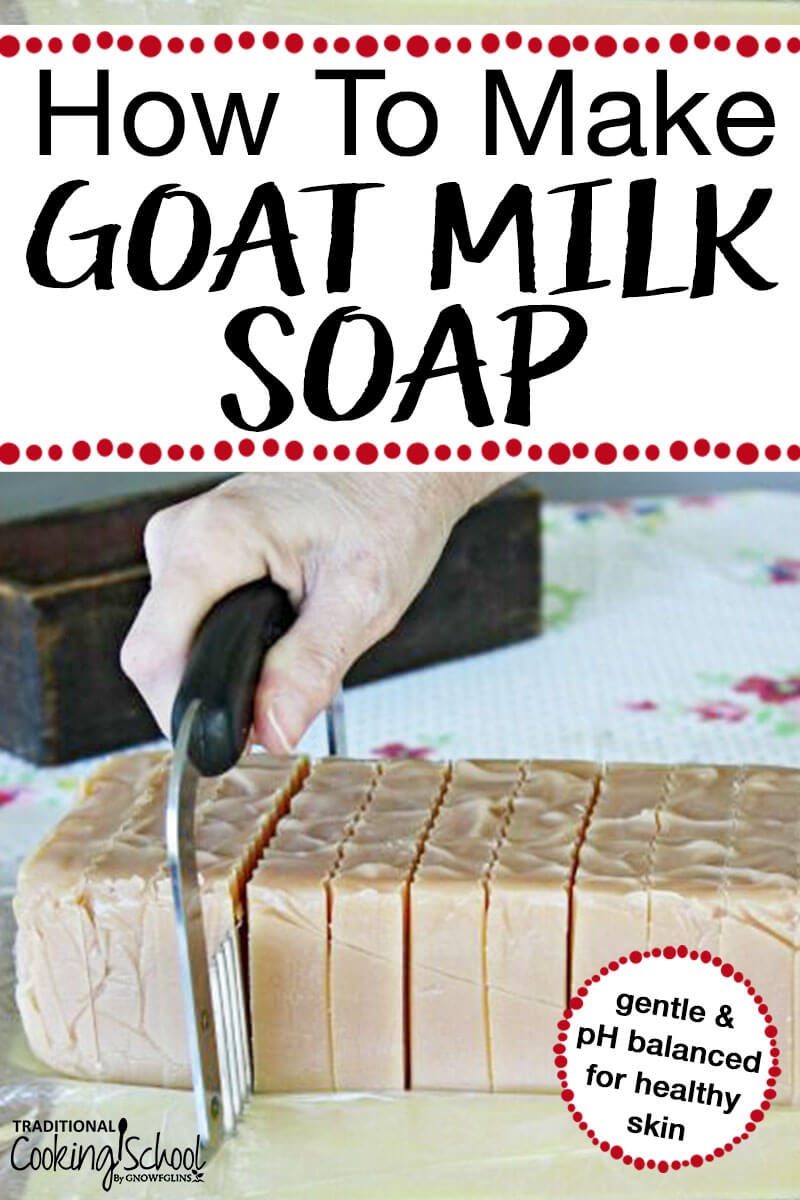
Do you know exactly what you're putting on your largest organ — your skin?
The products we use on our bodies should be just as safe and clean as the food we put in our bodies!
And one of the best ways to ensure this is to make your own bath and body products. It's easy to make your own deodorant, sunscreen, bug bite sticks, lotion bars, body butter, tooth powder and toothpaste, hair gel and hairspray, dry shampoo, and even soap — all at home!
Have I convinced you to give any of these a try, yet? 😉
I still remember what convinced me to make goat milk soap — bringing home our first 2 dairy goats! Their arrival sparked new ideas, dreams, and possibilities. Like what scent should my soap be? What about texture, like coffee grounds or oatmeal? What shape?
Thankfully, those type of decisions are the hardest part of the soap-making process. Although lye-based soap-making requires common sense and safety measures, it's very easy to do!
Benefits Of Goat Milk Soap
First of all, goat milk soap is very gentle and pH balanced. So if you have dry or sensitive skin, acne, or eczema, this is the soap for you!
Additionally, if you already have healthy skin, goat milk soap will keep it that way.
However, if you don't have access to goat milk, simply substitute an equal amount of water in place of the milk in this recipe.
Don't Get Burned!
Lye (sodium hydroxide) is a caustic chemical that can cause severe burns. So, before making soap, you need the following safety equipment:
- rubber gloves
- safety goggles
- medical-type face mask
In addition to these items, pour and stir the lye solution slowly and carefully to avoid splashing. Work in a well-ventilated area, and educate any family or friends present about the dangers of lye.
Use only plastic, glass, or stainless steel containers when mixing the lye. And be sure to label them for soap-making purposes only!
Remember that the lye in soap is still active until saponification (the chemical reaction that makes soap) is complete. This can take up to 24 hours.
Finally, don't be afraid — just be smart!
Gathering Your Supplies
You will need the following supplies. Items marked with an asterisk come into contact with lye, and should be used only for soap-making.
- frozen goat milk
- lye
- fats and oils (see recipe below)
- essential oils
- container to weigh lye crystals
- containers or bowls to weigh oils
- container in which to mix goat milk and lye (plastic, glass, or stainless steel)*
- spoon for mixing goat milk and lye (plastic, glass, or stainless steel)*
- stainless steel or enamel-coated pot for melting oils, and mixing lye + melted fats and oils together*
- long-handled whisk or immersion blender for mixing lye solution + melted fats and oils*
- kitchen scale
- 2 thermometers* (1 for measuring temperature of lye solution*, 1 for measuring temperature of fats and oils)
- rubber spatula*
- safety equipment: rubber gloves, safety goggles, mask*
- knife for cutting finished soap
- mold (wide, shallow box lined with grocery bag or wax paper; for round bars: 3-inch PVC pipe lined with parchment paper with a used canning seal at the bottom)
Let's Saponify!
sa•pon•i•fy: v. -fied, -fy•ing. v.t.
1. to convert (a fat) into soap by treating with an alkali.
In other words, let's put on those goggles, rubber gloves, and face masks! It's time to make soap!
I developed the following recipe using the SoapCalc website. The end result? A hard, creamy bar of soap with good lather and cleansing properties.
All ingredients are measured by weight, not volume. Remember to place your container on the scale and tare it before measuring the ingredients.
This soap-making method is called "cold process". The bars need to cure for 4 to 6 weeks before using.
Alternatively, "hot process" soap (like this) is cooked during saponification. This speeds up the process significantly, and means you can use the bars sooner. However, with hot process soap, you may lose some beneficial properties of essential oils due to adding them to a hot soap mixture.
Cold Process Goat Milk Soap
- 24.7 ounces frozen goat milk OR water (freeze milk in ice cube trays, then add cubes to scale until you reach the correct weight; do not freeze water)
- 6.7 ounces lye
- 18 ounces coconut oil
- 24 ounces lard
- 1 ounce castor oil
- 2 ounces olive oil
- 2 ounces essential oil(s) (optional; pick a single oil or a favorite combination!)
Prepare soap molds by lining with plastic, wax, or parchment paper.
Weigh out goat milk in designated milk/lye mixing container. Set aside. Weigh out lye crystals. Set aside. Weigh out essential oils. Set aside.
Weigh out coconut oil, lard, castor oil, and olive oil. Combine all in pot. Place pot over low heat until solid oils have melted completely. Remove from heat and set aside.
Then slowly pour lye into designated milk/lye mixing container. The milk will start melting right away. Carefully stir mixture until milk is melted. Once milk and lye solution is combined, place container in bowl of ice water so it can cool down. The milk and lye solution shouldn't be hotter than the oils — it needs to be the same temperature or within 10 degrees Fahrenheit cooler.
Check the temperature of the melting oils. I aim for it to be about 100 degrees Fahrenheit, with the milk and lye solution about 90 degrees Fahrenheit.
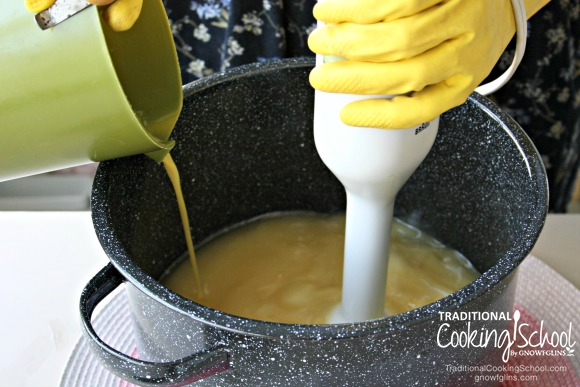
Once the milk and lye mixture is cool enough, carefully pour it into the pot with melted oils. Stir as you pour.
And then stir some more! Stir, and stir, and stir until the lye solution and oils are completely combined and reach "trace". Trace is the point where the oils and lye are completely combined and can no longer separate again. Think of it as emulsification, like when making mayonnaise.
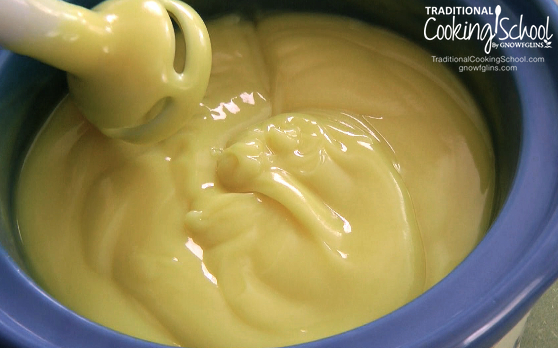
Test for trace periodically by pulling your whisk or immersion blender out of the mixture. Once it reaches trace, ridges and drips will form and won't go back down. It should be thick like gravy.
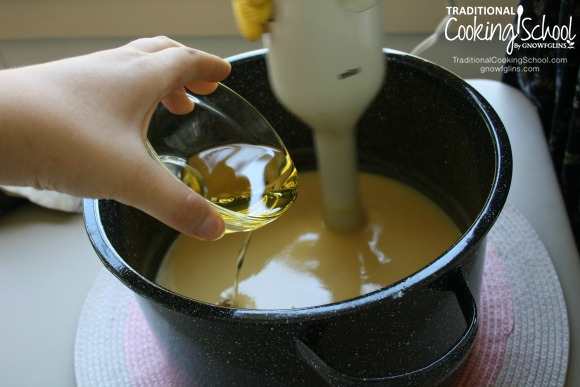
Once you reach trace, add any essential oils. Pour in and combine well. Check for trace again.
Then pour the mixture into soap molds, using a rubber spatula to smooth the top of your soap or create a nice texture. Keep in mind that the soap does not settle as it hardens.
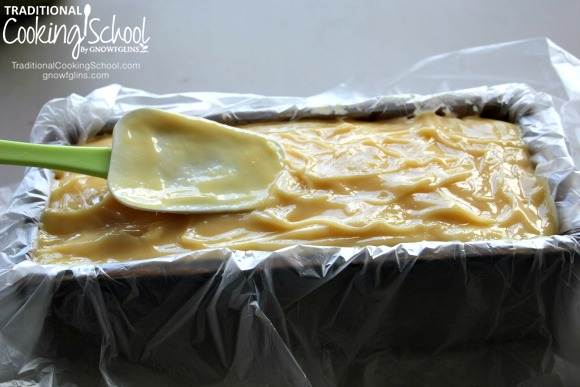
Finally, move soap to a cool, dark area and allow it to sit undisturbed for 24 to 48 hours. The lye can still be active for a while, so don't touch the soap with your bare hands until 24 hours is up!
Washing Up & Curing Soap
Now, look at the mess you've made! 😉 Wash any equipment used only for milk, oils, or fats (the container used to measure, the spoon used to stir, and thermometer).
Anything used for the lye solution (container used to mix milk and lye, the spoon used to stir, thermometer, pot, whisk or immersion blender, spatula) should be placed together and allowed to sit for at least 24 hours before washing. When it's safe to touch the soap, it's safe to touch the utensils.
Once 24 to 48 hours passed, unmold and cut soap into bars so it can finish curing. Simply flip the soap out of the mold, and peel away the plastic lining. Cut it using a knife, fishing line, dental floss, or a crinkle cutter.
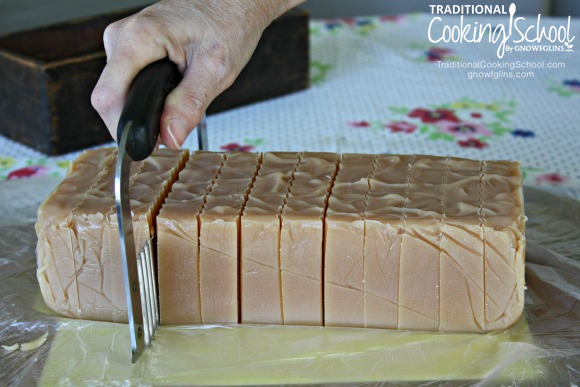
The bars of soap need to continue hardening and curing for another 4 to 6 weeks before use. Store the bars in a box, not touching each other so there is plenty of air flow. Flip and rotate the bars every few days so that all sides are exposed to the air periodically. Some people prefer to loosely cover the soap with a towel or lid, too.
When soap is hardened and cured, it's ready to use! Put a bar by each sink, or wrap some up and give it to a friend. Enjoy the soft, creamy lather and wonderful scent — along with the satisfaction of a job well done! You now know exactly what you're putting on your skin!
Have you ever made goat milk soap before? Will you give it a try?
We only recommend products and services we wholeheartedly endorse. This post may contain special links through which we earn a small commission if you make a purchase (though your price is the same).
How to Make Goat Milk Soap at Home Without Lye
Source: https://traditionalcookingschool.com/health-and-nutrition/tutorial-how-to-make-goats-milk-soap/
0 Response to "How to Make Goat Milk Soap at Home Without Lye"
Post a Comment